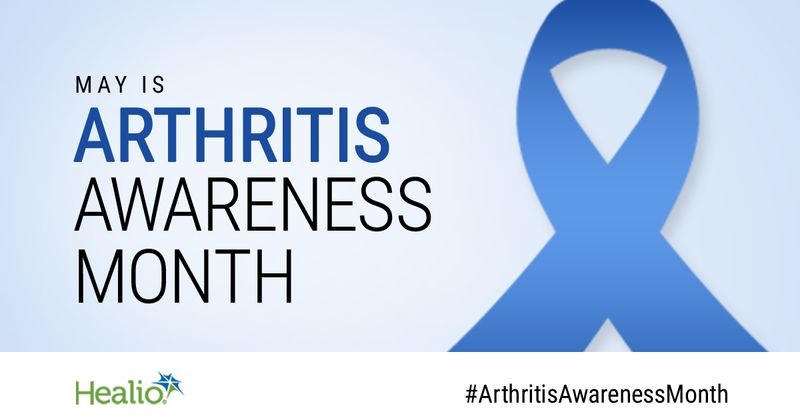Arthritis Awareness Month: Debunking myths, revealing truths
The month of May serves as Arthritis Awareness Month, drawing attention to this all-too common, yet misunderstood, condition.
Although misconceptions may lead people to discount the impact of arthritis, it is one of the most common health conditions in the United States and a leading cause of disability, according to the CDC. Nearly 59 million adults, or one in four, have physician-diagnosed arthritis.

Organizations like the Arthritis Foundation use this time to debunk myths and reveal truths about arthritis.
For example, some people may assume that arthritis has very little impact on the quality of life of individuals diagnosed with it, downplaying the potential severity of joint pain. However, routine activities like unbuttoning a shirt or opening a jar can be challenging and sometimes even physically impossible for patients with arthritis, according to the Arthritis Foundation.
In observance of Arthritis Awareness Month, Healio recaps the latest news and research concerning this underrecognized condition.
Biologics fill ‘very unique niches’ in gout management
Although many rheumatologists may not reach for biologic therapies for gout management, interleukin-1 and 6 inhibitors may have utility in managing mobilization flares, according to a speaker at the Basic and Clinical Immunology for the Busy Clinician symposium.
“Biologics and gout seem like an odd pairing,” Brian F. Mandell, MD, PhD, professor and chair of academic medicine in the department of rheumatic and immunologic diseases at the Cleveland Clinic, told attendees. “However, the fact is that biologics actually do work and fill very unique niches in this disease.” Read more.
Early-onset osteoarthritis cases have doubled globally since 1990
Incident cases of early-onset osteoarthritis have doubled globally over the last 3 decades, with the proportion of years lived with disability attributable to high BMI rising from 9.41% to 15.29%, according to data.
“Osteoarthritis is a leading cause of disability worldwide and is often considered as a condition of older people,” Qianlin Weng, of Xiangya Hospital at Central South University in China, and colleagues wrote in Annals of the Rheumatic Diseases. “However, there is a growing appreciation that young and middle-aged adults may also be affected.”
Izokibep meets ACR50 endpoint in PsA, has ‘deepening’ benefit in hidradenitis suppurativa
Izokibep achieved the primary endpoint of ACR50 response in a phase 2b/3 psoriatic arthritis trial, and demonstrated sustained, “deepening” benefit in hidradenitis suppurativa, according to top-line data from its manufacturer.
In a press release, Affibody Medical AB added that the drug additionally exhibited “robust clinical responses” for ACR70 and Psoriasis Area and Severity Index 100, as well as composite endpoints of ACR50/PASI100 and minimal disease activity, in PsA. Read more.
Increased cereal fiber intake may reduce rheumatoid arthritis risk
Individuals with higher cereal fiber intake are less likely to develop rheumatoid arthritis, according to data published in Nature Scientific Reports.
The researchers additionally concluded that the Dietary Inflammatory Index score is a “crucial intermediary” in this relationship, highlighting the role of diet in preventing and managing RA. Read more.
Serum urate predicts 10-year risk for recurrent gout hospitalization, flares
Patients with higher baseline serum urate levels demonstrate increased recurrent gout hospitalization rates and subsequent risk for flare over 10 years of follow-up, according to data published in JAMA.
The findings suggest that most gout flares are “potentially preventable at the population level” with the achievement of serum urate targets of less than 6 mg/dL or 5 mg/dL, Hyon K. Choi, MD,DrPH, director of clinical epidemiology at Massachusetts General Hospital, told Healio. Read more.
Patients with pro-inflammatory diet report worse knee osteoarthritis pain
Patients with pro-inflammatory diets demonstrate worse knee osteoarthritis pain and a greater risk for 10-year severe pain trajectory, according to data published in Arthritis Care & Research.
“The absence of drugs that can slow or reverse the progression of osteoarthritis and the challenges in effectively managing pain through analgesics have prompted the identification of factors that can be modified to address osteoarthritis progression and symptoms, such as pain,” Feng Pan, PhD, of the Menzies Institute for Medical Research at the University of Tasmania, in Australia, told Healio. “The dietary inflammatory index serves as a valuable tool, assessing an individual’s overall dietary pattern and its potential influence on inflammation, which is considered an important factor in the progression and pathology of osteoarthritis.” Read more.
Ancient skeleton with RA may suggest ‘we’ve been dealing with these diseases forever’
Archaeologists in Egypt recently discovered evidence of an ancient case of rheumatoid arthritis, potentially filling in the timeline of humanity’s relationship with autoimmune disease.
The skeleton was excavated in 2018 from an ancient cemetery in what is now Aswan, in southern Egypt, and determined to be that of a woman aged 25 years to 30 years who lived between 1750 BCE and 1550 BCE. Macroscopic examination revealed bilateral, erosive periarticular lesions with smooth borders on multiple hand and foot joints. A differential diagnosis, limited by a lack of X-ray imagery and other facts of the passage of time, suggested the woman most likely suffered from the condition we now know as RA, Madeleine Mant, PhD, of the University of Toronto Mississauga, and colleagues wrote in a study published in January in International Journal of Paleopathology. Read more.
References:
Arthritis Awareness Month: Expanding interventions for arthritis. https://www.cdc.gov/arthritis/communications/features/arthritis-awareness.html. Accessed Apr. 23, 2024.
Revealing the truth about arthritis during Arthritis Awareness Month. https://www.arthritis.org/news/revealing-truth-arthritis-arthritis-awareness-mont. Accessed Apr. 23, 2024.
